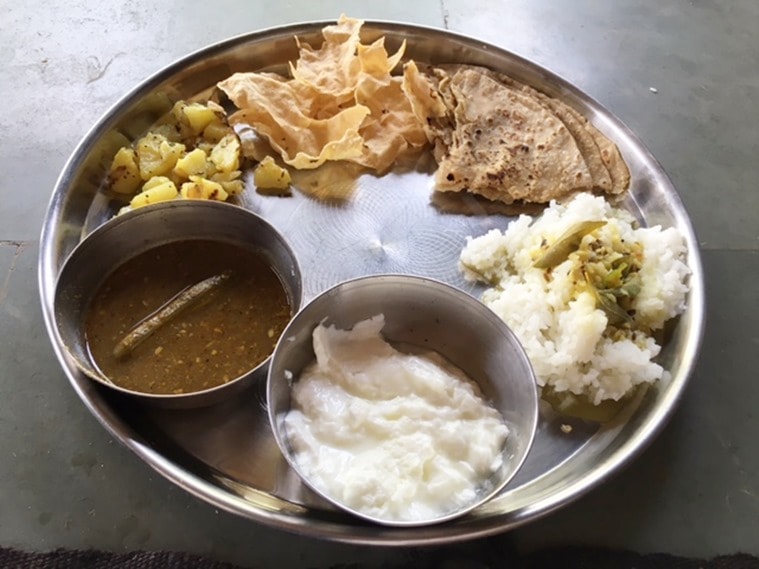The peculiar dilemma of accepting a lunch invitation in unyielding Marathwada
Moringa curry, jowari chi bhakri, and unwashed fruit. The food emerging from the kitchens of a region wracked by drought offers an illuminating lesson in sustainability.
 The author with the Zinjurkes (L), Dhamangaon’s sarpanch Muktabai Zinjurke in her kitchen. (Express photo by Amit Chakravarty)
The author with the Zinjurkes (L), Dhamangaon’s sarpanch Muktabai Zinjurke in her kitchen. (Express photo by Amit Chakravarty)
Here we are, at the home of Muktabai Zinjurke on yet another merciless day in Marathwada. The sarpanch of Dhamangaon is huddled over a stove preparing lunch for us. The lunch invitation, to the home of a villager in Ashti taluka, one of Beed’s worst-hit districts in ground zero of an unprecedented drought in Marathwada, should have provoked a dilemma of considerable proportions. A cup of tea — just how much water goes into producing the sugar in a cup? — a covert peg of rum, picking between wheat or millet chapatis — the most mundane things become deeply political choices in unyielding Marathwada. Admittedly, it did cause some soul-searching, but, after two hours under the blazing sun, in a land in which the horizons are marked by fleeting water mirages, my resolve wilts quickly.
I glance at my colleague and photo-journalist Amit Chakravarty to find he’s equally embarrassed. Equally exhausted, too. Let’s enjoy the meal, I tell him quietly.
I’ve had meals in Marathwada homes before. The memory of a ridiculously simple dish of sliced radish shallow-fried in ghee on a griddle with a pinch of salt and turmeric comes rushing back. That was seven months ago, and a series of experiments with the same ingredients in my own kitchen and my mum’s kitchen yielded unsatisfying results. Apparently, radish from the best organic foods stores in Mumbai cannot match the bittersweet, spicy crunch of bulbs dug up an hour before lunch is served. That was in Ambejogai town, and times were still not as bad as they are today.
Food, in a drought, has to be many things to many people. Certainly, it is an important aspect of government policy. Fodder for cattle and heavily subsidised food grain are both major interventions by the Maharashtra government this year. Across the world, school meals are implemented to offer some salve to communities that will take a while to heal. School-going children are commonly left behind in parts of Marathwada where seasonal migration in search of labour is traditional. Those children can now, in some villages, avail two decent meals a day in government schools. Also, across Beed, Osmanabad and Latur, the epicentre of this year’s continuing drought, farmers, home-makers and traders point out that the droughts of 2012 or 2015-16 are starkly different from the legendary drought of 1972 in one simple aspect: there was no food that year, as a critical grain shortage collided with a poor monsoon. The impressive presence of government interventions now ensures that food is available, to varying degrees, in most households. The crisis is one of finding water, for the home, for the livestock, and for the next crop.
 Drought-friendly cuisine: Drumstick curry, well-sauteed potatoes (as opposed to boiled), jowar chi bhakri and wheat chapatis and fresh curd. (Express photo by Kavitha Iyer)
Drought-friendly cuisine: Drumstick curry, well-sauteed potatoes (as opposed to boiled), jowar chi bhakri and wheat chapatis and fresh curd. (Express photo by Kavitha Iyer)
So, when the meal starts, unusually, with a huge platter of fresh fruit, I’m surprised. It’s not a practice, I find out. There are 15 minutes to go before lunch is served, and the fruit — bananas, chikoos, and apples served whole, with a large knife alongside the sharing platter — is a quick-fix of sorts. Nobody is washing the fruit, I notice, so I start conservatively with a banana. A little later, refuelled by the sugar rush and the sweet coolness of the chikoo (unwashed), my mind begins to hum.
What would be drought-friendly cuisine at the Zinjurkes’ home? Vegetarian, without a doubt. For that would mean a smaller water footprint, and it would also be more economical for household expenses already stretched thin by a rural economy in tatters. Food in rural Maharashtra is routinely a fiery affair, especially if there’s meat involved. The thechha, basically ground green chillies with a variation of salt, garlic, red chillies or peanut crush, is to be consumed sparingly, I warn myself.
What emerges from the kitchen, instead, is a lesson in sustainability like none I’ve had.There’s jowari chi bhakri, hand-patted chapatis of millet flour. Sorghum, after all, is the only crop that stands in sparse portions across the region’s otherwise arid fields. A crop that needs one spell of rainfall is how many farmers have described it to me. For those who don’t care for the coarse taste of jowar, there are wheat chapatis. These are served in quarters, a tradition unique to rural Maharashtra. The neater the pile of quarters, the more care and nurture has been lavished by the head of the kitchen. “You’re also less likely to count how many chapatis you’re eating if you eat quarters,” says Pandurang Zinjurke, the ‘sarpanch-pati’, or husband of the sarpanch, hardly a constitutional post but one he takes seriously enough.
There’s a preparation of potatoes, well-sautéed instead of boiled, with cauliflower. Potatoes are a staple for guests, I’m told. It is a vegetable that nobody objects to and incidentally one that is seeing growing research in water-use efficiency. There’s a watery dal, perhaps the solitary giveaway of how it’s time to cut some corners even in the more well-off households. The drumstick curry is a surprise, the leaves of the moringa plant crushed into the preparation. The moringa or drumstick plant has grabbed attention in drought-hit regions the world over, as a drought-tolerant tree that grows fast, without fuss, its leaves making it to avant garde restaurants’ salads and dieters’ charts. This one is milder than other curries I have tasted in this region before, but the nutty taste of the crushed leaves gives me an idea. Yes, good old murangakka sambar — how would that be with the moringa leaves chopped into the tamarind water?
But it’s the curd that is the standout, fresh and luscious, perfectly cool and comforting. There is no cutlery, of course, so there’s only one thing to do: I dip my fingers in, lick them clean. It’s been a satisfying meal, in its simple goodness and in the questions it raises about sustainability, drought, scarce resources and mindless urban consumption.







- 01
- 02
- 03
- 04
- 05




















